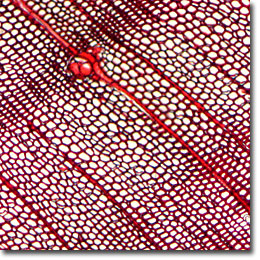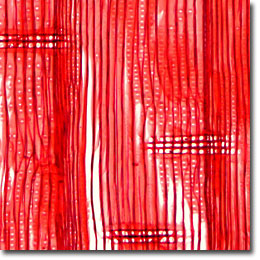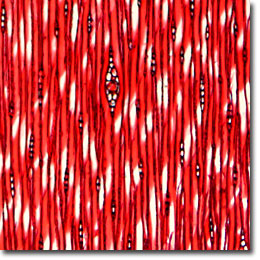The White Pine
The White Pine (Pinus strobus; also known as the Eastern White Pine and the Northern White Pine) is a softwood evergreen found primarily throughout southeastern Canada and the northeastern United States. The sapwood ranges from nearly white to a pale yellow, while the heartwood is cream colored to light or reddish brown, turning much darker on exposure to the atmosphere after the tree has been cut.

Cross Section

Radial Section

Tangential Section
White pines, one of the most utilized timber pines in North America and perhaps the most beautiful of all eastern species, often grow to heights of 140 feet with trunk diameters ranging between 3 and 5 feet. The leaves are a soft, bluish green, average 3 to 5 inches in length, and are bundled five in each sheath. The cones are cylindrical and 4 to 8 inches long. Propagation is by seed cone, and the tree grows in a wide variety of soils and can withstand substantial shade. However, the white pine is generally intolerant of inner-city air pollution or salt spray from highways or seashores. Large quantities of eastern white pines are shipped to Europe and the Far East each year for use as lumber.
White pine lumber was first exported to England in 1605, and it soon became fully appreciated by the British royalty whose American colonial subjects "marked" trees for exclusive use by the Royal Navy for ship construction. White pine wood is used for toys, woodenware and novelties, signs, caskets, building construction (formerly the leading wood, now largely replaced by western white pine and aspen), shade and map rollers, and Venetian blinds.
Microscopic examination of iron-alum hematoxylin and safranin stained thin sections (see the digital images presented above) reveals tracheids ranging between 25 and 35 micrometers in diameter and bordered pits that occur in a single row or occasionally paired on the radial walls. Longitudinal parenchyma is lacking, and the rays are of two types: uniseriate and fusiform with resin ducts and nondentate. Resin canals have thin-walled epithelium in the sapwood, but thick-walled in the hardwood and are frequently occluded with tylosoids.